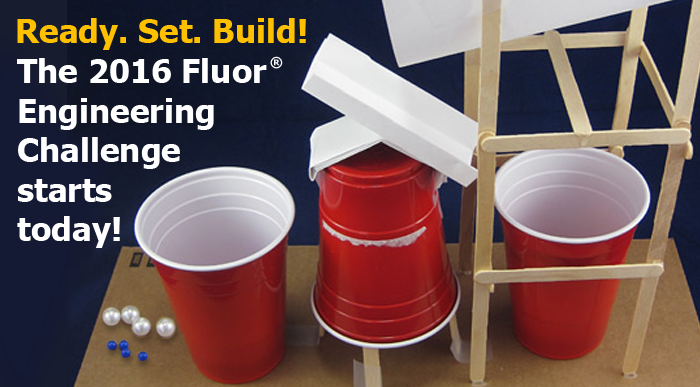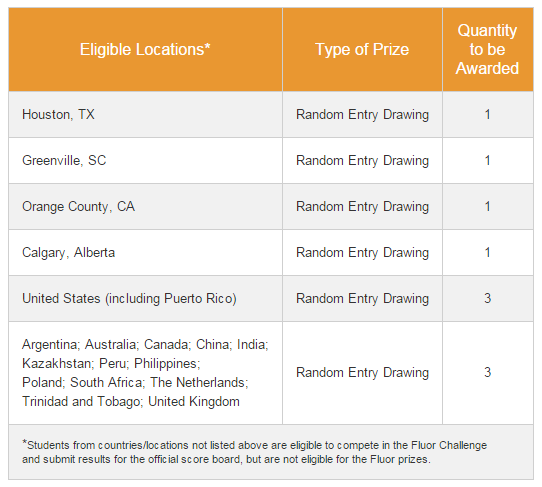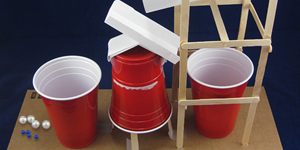Make a Marble Sorting Machine
Encourage students to be engineers as they design, test, and improve their own marble sorting machines for this year's Fluor Engineering Challenge. A combination of speed and accuracy is required to make it to the leader board. Can your students solve this year's Fluor Engineering Challenge?

Ready. Set. Build! The 2016 Fluor Engineering Challenge starts today!
Last year, students around the world got hands on inventing their own balloon-powered vehicles as part of the 2015 Fluor Engineering Challenge. It was inspiring to see the range of creative and innovative solutions students came up with when presented with the fun engineering challenge.
This year, Fluor and Science Buddies are proud to launch another exciting engineering design challenge for K-12 students: make a marble sorting machine.
The 2016 #FluorChallenge
The 2016 Fluor Engineering Challenge involves designing, prototyping, testing, and improving a marble sorting machine. Using the limited materials allowed for the challenge, and following all challenge guidelines, students are challenged to design a paper-based machine that can sort marbles into different cups based on the size of the marble. It will take creative thinking, trial and error, and hands-on engineering to design a marble sorting machine that meets the 2016 Fluor Engineering Challenge requirements and also performs effectively. Students will measure their marble sorting machines based on speed and accuracy to come up with their final score.
The Marble Machine project for this year's challenge is an adaptation of a challenge Fluor employees did as one of their annual company-wide employee challenges. View the slideshow in the project to see some of the awesome designs Fluor engineers created in response to their own marble machine challenge.
Take the Challenge
The 2016 Fluor Engineering Challenge opens today, February 11, and runs through March 11, 2016. Students who live in one of the geographic locations noted on the chart below can take the #FluorChallenge and enter for a chance to win. Students in eligible locations who complete the challenge and submit their designs and scores will be entered in a random drawing to win a $1,000 USD grant for their qualifying community organization or school. (Note: available cash awards are limited to the locations listed, but all students are invited to take the challenge and submit their designs for a chance to be included on the 2016 Fluor Engineering Challenge leaderboard.)

For the 2016 Fluor Engineering Challenge rules, guidelines, and directions for entering the contest, visit: sciencebuddies.org/fluor-challenge. For the project directions, including the allowable materials list, see the Marble Machine project idea at Science Buddies.
Make it a Classroom Activity
Are you and your students ready to design marble sorting machines? The 2016 Fluor Engineering Challenge is a great activity to do with students in celebration of E-Week. Students can work alone or in teams of up to four. Before starting, students should be careful to review the allowable materials list (and limitations), scoring criteria, and rules and guidelines for the 2016 Fluor Engineering Challenge.
To help your students prepare for the challenge, review the steps of the Engineering Design Process and encourage students to make changes to their designs in response to what they see works and doesn't work with their marble sorting machines. A great engineering design often requires multiple iterations on the path to an efficient, working design.
How can students tell if a design works? How can students tell if a design is efficient? Test it! Students can use the scoring sheet to evaluate how well a marble sorting machine works. Tracking improvement in speed, accuracy, or overall efficiency over a period of design iterations is a great way for students to see, firsthand, the value of testing, prototyping, and modification at the heart of the Engineering Design Process.
Questions to ask your students:
- What problems are you encountering?
- How can you alter your design to specifically target the problems you see in your tests?
- Did the changes you made result in a change in speed, accuracy, or overall efficiency?
- Are there changes you can make in the materials used to improve the score?
Resources for Teachers
The following resources are designed to help teachers integrate hands-on engineering in the classroom as part of their curriculum and Next Generation Science Standards (NGSS):
- Teacher/Implementer Toolkit for the 2016 Fluor Engineering Challenge
- Helping Teachers Approach Next Generation Science Standards
- Understanding the Engineering Design Process: Teachers Embracing Engineering Design
- Engineering Project Guide (student resource)
- New Science Standards Emphasize the Engineering Design Process
- Mapping Science Buddies Content to Core Teaching Standards
- Comparison of the Scientific Method and the Engineering Design Process (side-by-side comparison of the two methods, suitable for printing as a classroom poster)
Spread the Word!
Share your enthusiasm for the 2016 Fluor Engineering Challenge by letting others know on Facebook, Instagram, or Twitter that you are taking this year's challenge. Once you have started building your marble sorting machine, show it off. Be sure and tag your status update, post, or tweet with #FluorChallenge to be part of the community surrounding this STEM event. Include @ScienceBuddies in your post, too!
We can't wait to see what you invent and how you solve this year's Marble Sorting Machine challenge!
Fluor is a registered service mark of Fluor Corporation. All rights reserved.
Categories:
You Might Also Enjoy These Related Posts:
- Plastics and Earth Day - Science Projects
- Arduino Science Projects and Physical Computing
- 10+ Robotics Projects with the BlueBot Kit
- 5 STEM Activities with Marshmallow Peeps
- March Madness Basketball Science Projects: Sports Science Experiments
- Women in STEM! More than 60 Scientists and Engineers for Women's History Month
- Explore Artificial Intelligence and Machine Learning with Student AI Projects
- 10 Reasons to Do the Rubber Band Car Engineering Challenge










